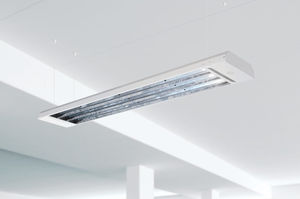
Wall infrared heater Y9000hangingceiling-mountedelectric






Add to favorites
Compare this product
Characteristics
- Installation
- wall, hanging, ceiling-mounted
- Energy source
- electric
- Market
- industrial
Description
Specifications
Power nominal Watt - 9000
Voltage, V/Hz - 400/50
Dimensions, mm - 1930/622/80,5
Heating m2 (main) up to - 90
Min Height - 4,5-20
Warranty, years - 1
INFRARED INDUSTRIAL ZONAL HEATER BILUX Y9000
Appliance: This model is designed specifically to create warm zones in industrial premises with high ceilings, as well as in premises where a beam crane is installed (heaters can be located above the beam crane).
It is used for heating of industrial, trade and sports premises. It also can be used for zonal heating of working, gaming or trade zones as well as temporary heating, for example heating the volleyball playfield during the game or heating the stage during the concert.
Effect on the human body: BILUX "Y" series heaters are mid-wave infrared heaters, it is not recommended to stay under it for 24 hours, and a temporary stay under the warm rays of the BILUX Y9000 will be beneficial.
Technical features:
- Maximum efficiency of the heater is achieved when installing it on the ceiling parallel to the floor, you can also install it by angle but it should not be more than 30 degrees.
- Minimal height of installation should be around 1 meter above the head, not less than 3 meters from the floor.
- Reaching the operating temperature up to 30 minutes, warming up the premise from 30 minutes to 4 hours.
WARNING: the heat plate becomes red-hot to 500 degrees Celsius! Do not touch while working!
Temperature control system: Be sure to use thermostats. There are several varieties for different purposes.
Catalogs
BILUX - Catalog
12 Pages
*Prices are pre-tax. They exclude delivery charges and customs duties and do not include additional charges for installation or activation options. Prices are indicative only and may vary by country, with changes to the cost of raw materials and exchange rates.







